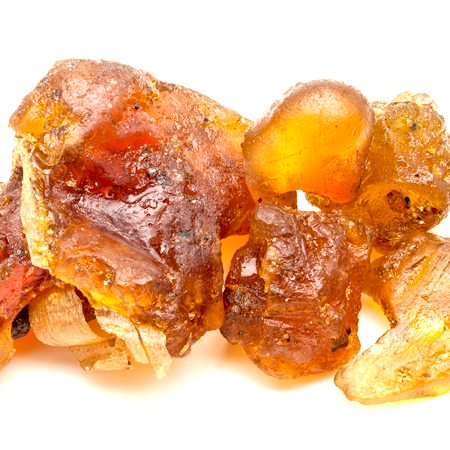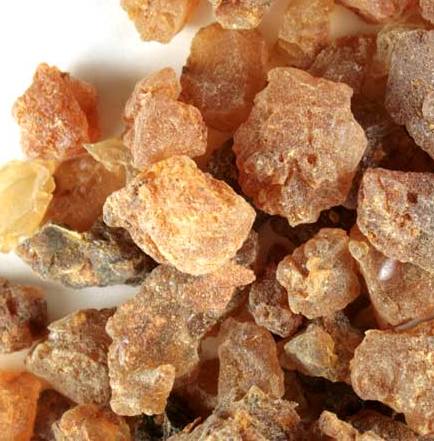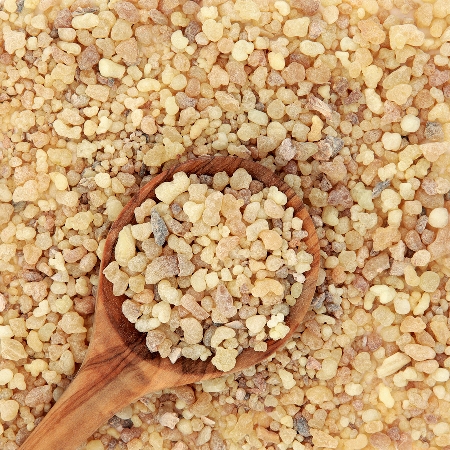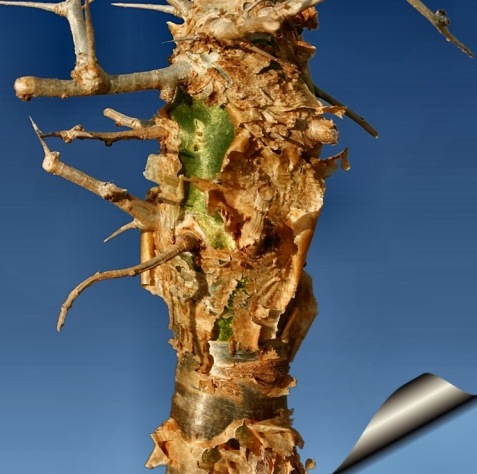




Botanical name Commiphora myrrha
Botanical synonym Commiphora molmol Engl.
Family Burseraceae
Source Dried gum oleoresin
Origin India
Processing Method Solvent Extraction using Benzyl Benzoate
Color/Consistency A medium to viscous, dark brown liquid.
Aromatic Summary / Note / Strength of Aroma A middle note with a medium aroma, Myrrh Resinoid has a warm, rich, spicy balsamic odor.
Blends With Lavender, Bay, Orange, Geranium, Clary Sage, Rosemary, Lime, Petitgrain, Mandarin and Coriander.
Product Abstract
Because of its versatility and effectiveness, myrrh has been valuable across many cultures for centuries. With countless applications, myrrh was used anciently for everything from medicine to religious purposes. Today, the resin extracted from the myrrh tree is transformed into an herbaceous, woody essential oil that still holds relevant applications. Whether you want to promote smooth, youthful-looking skin, promote emotional balance, or cleanse the body, Myrrh essential oil holds limitless uses for everyday life.
History
The word "myrrh" comes from "murr," which means "bitter" in Arabic, probably referring to the resin's bitter taste. Myrrh was very popular among ancient cultures. The Chinese valued it as a medicine, while Egyptians used it for embalming their pharaohs as well as for their sun-worshipping rituals.
In fact, myrrh was mentioned in Ebers Papyrus, one of the oldest Egyptian medical texts, dating back to 1550 BC. Even the Greek soldiers made use of this resin, bringing it with them to battle to stop their wounds from bleeding.
Harvesting/Extraction Information
The essential oil of myrrh is extracted from resin. Myrrh, in the scientific nomenclature system, is called Commiphora Myrrha and is native to Egypt. The resin was frequently used in incense and perfumes in ancient Egypt, and the oil obtained from it was used for healing wounds in ancient Greece. The main components of this essential oil are alpha-pinene, cadinene, limonene, cuminaldehyde, eugenol, cresol, heerabolene, acetic acid, formic acid, and sesquiterpenes.
Common Usage
Caution
Despite these benefits of myrrh essential oil, it can have toxic effects if used in excess. It should be avoided by pregnant women since it stimulates the uterus and could result in miscarriage.
Key constituents
Furanoeudesma-1,3-diene 34.0%
Furanodiene 19.7%
Lindestrene 12.0%
b-Elemene 8.7%
Germacrene B 4.3%
Germacrene D 3.2%
d-Elemene 2.1%
2-Methoxyfuranodiene 2.1%
Isofuranogermacrene (curzeree) 2.0%
T-Cadinol 1.6%
b-Caryophyllene 1.3%
b-Bourbonene 1.2%
g-Cadinene 1.2%
Furanoeudesma-1,4-diene 1.2%
g-Elemene 1.1%
Safety summary
Hazards May be fetotoxic, due to b-elemene and furanodiene content.
Contraindications (all routes) Pregnancy, lactation.
Organ-specific effects
Adverse skin reactions Undiluted myrrh oil was not irritating to mice or pigs; tested at 8% on 25 volunteers it was neither irritating nor sensitizing. Myrrh oil is not phototoxic. Myrrh oil was concentration-dependently irritating to the ear of albino mice, causing irritation in 12/12 animals at 0.1 mg/mL and 4/12 animals at 0.15%. A 65-year-old aromatherapist with multiple essential oil sensitivities reacted to both 1% and 5% myrrh oil.
Reproductive toxicity: The administration of a combination of myrrh resin and essential oil to pregnant rats at 50–200 mg/kg/ day on gestational days 6–15 did not increase abnormalities of the fetal skeleton. Both furanodiene and b-elemene are antiangiogenic. In view of the probable link between antiangiogenic effects and reproductive toxicity, we have contraindicated myrrh oil in pregnancy and lactation.
Hepatotoxicity A single oral dose of 12.5, 25 or 50 mg/kg of furanodiene dose-dependently protected mice against liver injury induced by D-galactosamine/lipopolysaccharide or TNF-a.
Systemic effects
Acute toxicity: Myrrh oil acute oral LD50 in rats: 1.65 g/kg.
Antioxidant/pro-oxidant activity The essential oil from Somalian Commiphora myrrha displayed an antioxidant activity against singlet oxygen greater than that of ()-a-tocopherol. Singlet oxygen is a major player in lipid peroxidation, phototoxicity and DNA degradation.
Carcinogenic/anticarcinogenic potential No information was found for myrrh oil, but it contains no known carcinogens. Furanodiene demonstrated an in vitro anticarcinogenic action against human liver cancer cells by preventing tumor cell growth and inducing apoptosis. Furanodiene inhibited proliferation of six cancer cell lines with IC50 values of 0.6–4.8 mg/mL, and of uterine cervical and sarcoma tumors in mice. b-Elemene displays anticarcinogenic activity.
Comments
There appears to be a considerable discrepancy in the mouse skin irritation data reported by Opdyke. The general perception is that myrrh oil should only derive from C. myrrha. However, there are over 150 species of Commiphora, and myrrh oil may wholly or partly come from species such as C. Africana, C. erythraea, C. holtziana, C. kataf, C. madagascariensis, C. mukul, C. schimperi and C. sphaerocarpa. Essential oils from other species have significantly different chemical compositions to that of true myrrh. Curzerene is the major constituent of. myrrha var. molmol oil. Many early reports of myrrh oil composition include constituents that are not present in true myrrh oil, such as curzerenone and dihydropyrocurzerenone; a careful analysis of the oil will reveal such adulteration.